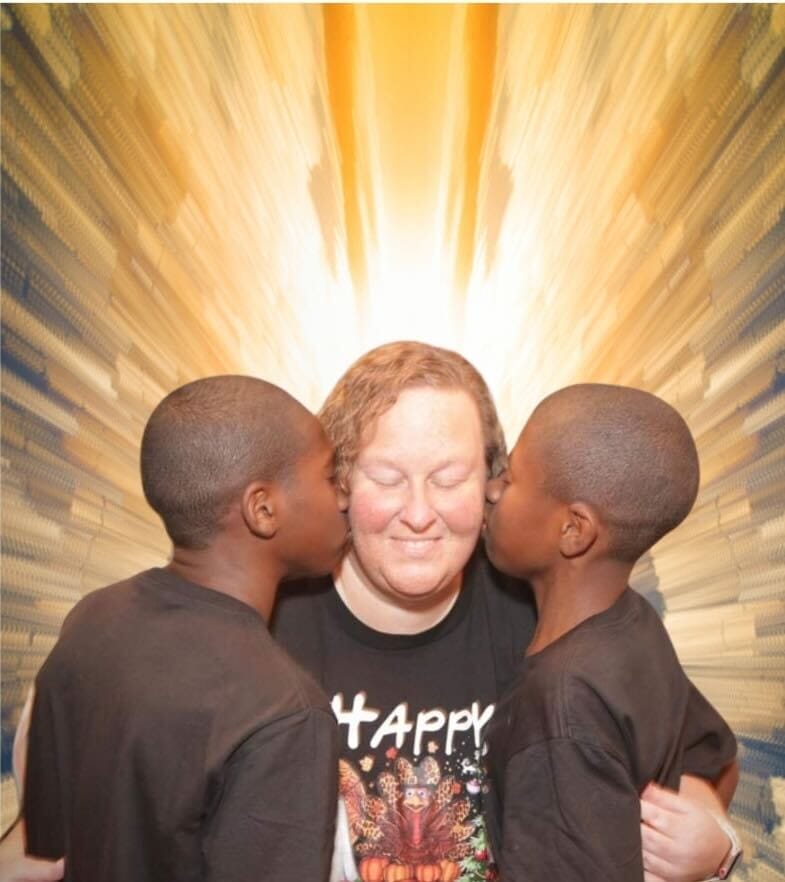This picture is a vibrant tapestry woven from love, life and unforgettable memories. It captures a moment I want my boys to hold close: a snapshot of their mama who loved them fiercely, stood by their side through thick and thin, and always aimed for their happiness.
My hope is that they see a mama who fought valiantly every day, never backing down, embodying strength even when faced with challenges. This picture symbolizes my flowers blooming amidst the valley.
What is ATTR-CM?
Transthyretin amyloidosis cardiomyopathy (ATTR-CM) is a rare progressive disease of the heart muscle that leads to congestive heart failure. It occurs when the transthyretin protein produced by the liver is unstable. Symptoms include fatigue; shortness of breath; irregular heart rate or palpitations; swelling of the legs, ankles and stomach; brain fog; wheezing; and dizziness. It often goes underdiagnosed because of a lack of awareness and knowledge of the disease. There is currently no cure for ATTR-CM.
Ah, limits. None of us really like them, and I’m no exception. Being diagnosed with transthyretin amyloid cardiomyopathy (ATTR-CM) brings a whirlwind of challenges. Each day presents a fork in the road, forcing me to make choices about which path to take.
Read more about ATTR-CM signs and symptoms
My journey is deeply personal. I was once a daughter and caregiver, witnessing my father’s battle with this disease until he passed away in 2010. Now, as a wife and mother of two teenage boys, I feel the ripples of this illness in our daily lives. Raising two teenagers adds a complicated twist to the hurdles I already face.
My body has other plans
Naps? No, thank you. I’ve always despised them. My husband, on the other hand, would take a nap every day if he could — it’s his secret to bliss. For me, napping feels like missing out on the richness of life. Yet, as much as I resist, I’ve realized those quick power naps are often what get me through the day. I’ve found myself unintentionally dozing off while we drive to church or after enjoying a meal. It’s frustrating — my mind wants to seize the day, but my body has other plans.
Breathlessness has become an all-too-frequent companion, turning simple walks into herculean tasks. The other day, as my oldest son trekked to meet his NJROTC commanding officer, I struggled to keep up. I had to pause and catch my breath halfway there, and it stung. I felt defeated, my body betraying my spirit. How could I not keep up with my son? Finding that balance is an ongoing battle, and some days I feel like I’m losing ground.
And then there’s my youngest son, still very much in a self-centered phase of life. We’re guiding him to look beyond himself, but that perspective provides him a sense of security, something my oldest son doesn’t share. He watches his little brother and observes how this disease changes our family dynamics. It’s touching how he sometimes holds back from sharing certain NJROTC activities, knowing they might be too hard for me to process. His concern weighs heavily on my heart, and I can’t imagine the burden he carries as a 15-year-old navigating his own emotions while watching his mother struggle.
All these limits can feel oppressive, leading to isolation. As a 47-year-old woman facing this diagnosis, I often feel like an outsider, even among others living with the disease. If I feel this way, what must it be like for my teenagers? So what’s the answer?
It’s in our hands
Each day brings a crossroads — a chance to choose how to embrace life. Every morning starts with gratitude for another day. Then comes the decision: Do I focus on my losses or celebrate what I’m gaining? I like to think of it as my flowers in the valley.
Life used to be something I took for granted, but that’s changed. Now, I’m fully aware of its preciousness. I used to be the one taking photos, always behind the camera, but now I ensure I’m in those frames, too, committed to creating lasting memories. I’m grateful for my two teenage boys who still want to spend time with their parents. Whether it’s family game night or just hanging out, these moments are treasures. I even write journals to my husband and boys, filled with thoughts I want them to remember long after I’m gone.
Distance became a bridge rather than a barrier between my sister and me. Living in South Carolina while she’s in Pennsylvania meant we only saw each other once a year. But since my diagnosis, that has changed: We now cherish each other’s company five times a year. Together, we created a special holiday we call Hallowthanksmas, blending elements of Halloween, Thanksgiving and Christmas. The picture you see is from our latest celebration, filled with joy and laughter.
While living with this disease brings inevitable limitations, how we respond to them is entirely in our hands.
This picture stands as a testament to love, life and the cherished memories we create together. I want my boys to remember their mama as someone who loved them fiercely, stood proudly by them, and constantly aspired for their happiness. I hope they see in me a woman who fought tirelessly, never surrendering to despair. This picture is my declaration of flowers blooming amidst the valley.


